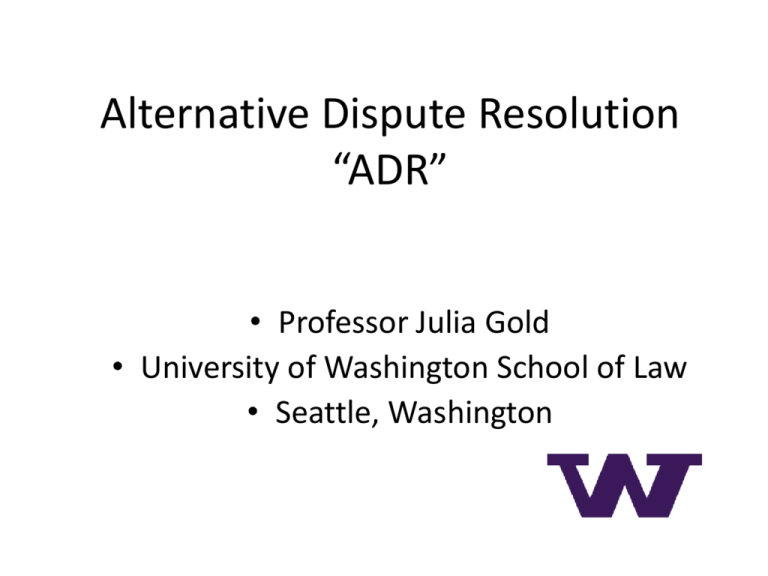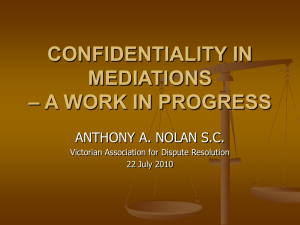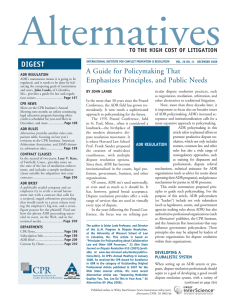Mediation
advertisement

Alternative Dispute Resolution “ADR” • Professor Julia Gold • University of Washington School of Law • Seattle, Washington Alternative Dispute Resolution: alternatives to having a court decide a dispute in a trial of the case. • What percentage of civil cases are tried in a court? – In Slovenia? In the U.S.? • ADR goal: “Fitting the forum to the fuss” or appropriate dispute resolution – Process choice: which process best meets the client’s needs? Objectives for this Class • Review different types of ADR processes • Experiential activity • Discuss growth of ADR in United States and reasons for its popularity • Advantages and disadvantages of different processes • If time, case study • Q and A Hybrid Processes Med-Arb Early neutral evaluation Summary jury trial Mini-trial Negotiation Court Arbitration Voluntary, binding Compulsory, non-binding Administrative agency Mediation Adjudication Primary Dispute Resolution Processes Primary DR Processes • Negotiation: disputants negotiate for themselves, may be represented by attorneys. Decisions made by the disputants. • Mediation: impartial third party facilitates discussion of matters in dispute and assists disputants to reach a mutually acceptable agreement. • Arbitration: impartial third party selected by the disputants. Arbitrator conducts an informal hearing and makes a decision, which may be binding or nonbinding. Small Group Activity • Divide into groups of 3. • Once in your group, decide who will be Marija, Darja and the neutral third party, review your information • Wait until I tell you to begin • Round 1—two minutes for each person to argue, neutral arbitrator asks questions, makes decision. Wait for me to tell you to begin Round 2!! • Round 2—switch neutral with another group, then neutral acts as mediator, Marija & Darja start over and discuss as though no Round 1 • When you finish, discuss in your small group what was different about the two processes. Debrief • What was the outcome? • Which process was more appropriate for this dispute? • What was different? • Parties (Marija and Darja): which did you prefer and why? • Neutrals: which did you prefer and why? Reasons: Growth of ADR in U.S. • Costs of litigation increasing • Long delays for trials, especially in larger cities • Desire for privacy, control, flexibility • Dissatisfaction with court outcomes Starting in late 1960’s & 1970’s, judges, lawyers, court administrators called for change Dream of the “multi-door courthouse” Now in most jurisdictions ADR is a requirement before a trial History of ADR in U.S: Community-Based • Starting in the 1960’s, local DR centers formed to address conflicts in communities (racial, neighborhood) using volunteer mediators • Citizens volunteer as mediators and dispute resolvers, not just lawyers • Nationwide network of community dispute resolution centers has developed throughout the U.S. History of ADR in the U.S: Court-Connected • Need: Increase in litigation (especially divorce) led to expensive, slow, “all or nothing” approach, limited role for parties • 1970’s-Judges and lawyers advocated for a better way to tailor the process to the dispute • Proliferation of court rules, statutes • Both public and private providers • Mediation is becoming preferred process, in both trial and appellate courts Effects on U.S. Justice System • Growth of private ADR firms • Retirement of judges to become private mediators and arbitrators • Number of cases going to trial has greatly decreased-- the “vanishing trial” • 1999-California Task Force to study effects of ADR on quality of justice: – Concluded that ADR improved quality of justice for litigants with greater choice, speed, savings, satisfaction Advantages and Disadvantages of Different Processes Litigation: Advantages • Creates a precedent, helps define social norms • Involuntary: can force other party to participate • Right to appeal • Proceedings are public—helpful when issue of public interest • Ability to punish wrongdoers publicly Litigation: Disadvantages • Adversarial process inhibits cooperation, may damage future relationships • Parties lose control of outcome • Parties cannot choose decision-maker, as with arbitration • Skill of lawyers of crucial importance • Expensive and time-consuming • Only resolves issues that are legal causes of action • Win-lose outcomes • Parties’ participation limited, compliance lower Litigation: Suitable Case Characteristics • Need for precedent • Important social issue at stake where public forum most appropriate • Adversarial stance of parties makes voluntary resolution unlikely • Parties willing to spend money, time Arbitration: Advantages • Parties control process and select neutral (who may be expert in substantive area of law or subject matter) • Outcomes tailored to needs and interests of parties • Broader range of issues can be decided • Confidential • Faster, cheaper • Parties assured of final resolution • Greater satisfaction with outcome, higher level of compliance Arbitration: Disadvantages • • • • No formal public precedent created Very limited right to appeal Outcomes are “win-lose” Issues limited to those agreed to by both parties • Adversarial process may limit ability to develop creative solutions Arbitration: Suitable Case Characteristics • • • • • Desire to avoid publicity, have privacy Need “expert” or trusted third party to decide No need for precedent Want fast, binding decision by third party Dispute has limited potential for creative resolution Mediation: Advantages • Parties retain control of process and outcome • Outcomes tailored to needs and interests of parties • Broader range of issues can be decided • Improves parties’ capacity to resolve future disputes • Confidential • Faster, cheaper • Greater satisfaction with outcome, higher level of compliance Mediation: Disadvantages • No precedent created • Societal norms for behavior not created, refined • May advantage more powerful party • Since voluntary, may be difficult to ensure participation • Does not guarantee end to dispute Mediation: Suitable Case Characteristics • Parties have ongoing relationship or potential for a future relationship • Dispute raises non-legal issues • Creative solutions possible • Future dealings will benefit from improved communication • Multiple issues, with possibility of trade-offs Typical Cases-Mediation • Civil: commercial contracts, torts, employment disputes • Family, especially when children involved • Small claims • Neighborhood, interpersonal disputes • Environmental, public policy Mediation Values • • • • • Process is consensual Party self-determination Mediator impartiality Confidentiality Consideration of not just legal but also human and business aspects of a case ADR: Common Elements of all Processes • Relieves attorney from initiating settlement discussions • Promotes early settlement • Promotes participation of key decision-makers • Relieves pressure on courts/judges by using attorneys as neutrals • More flexibility • Avoids involving trial judge in settlement discussions Matching the Process to the Dispute: Considerations • Nature of the dispute, goals of client – Fact-finding, vindication, punishment, state enforcement of remedy, establish precedent, strategic use of litigation? • • • • • Relationship between the disputants Amount in dispute v. costs of trial Need for speedy resolution Desire for control of outcome Does client want active role? Case Study • ABC Electronics is a small company that makes and sells computer parts for small industrial manufacturers. One of ABC’s best customers for the last 5 years has been Export Industries. In March 2011, the owners of the two companies negotiated a contract, for delivery of 500,000 Euro worth of parts to Export Industries, to be delivered on September 1, 2011. Due to difficulty obtaining necessary computer chips, ABC was unable to deliver the product by Sept 1, causing Export substantial financial loss. Export has threatened to bring a lawsuit against ABC for breach of contract. • Discuss with one or two other students: • What ADR process should these two companies consider using to resolve this dispute and why? Questions?? Controversial Issues in ADR • Effects of disproportionate power – Use in domestic violence cases • • • • • • • Cultural differences Extent of confidentiality Mandatory participation in mediation Good faith bargaining requirements Enforcement of mediated agreements Certification and licensing of mediators Role of lawyers as mediators





